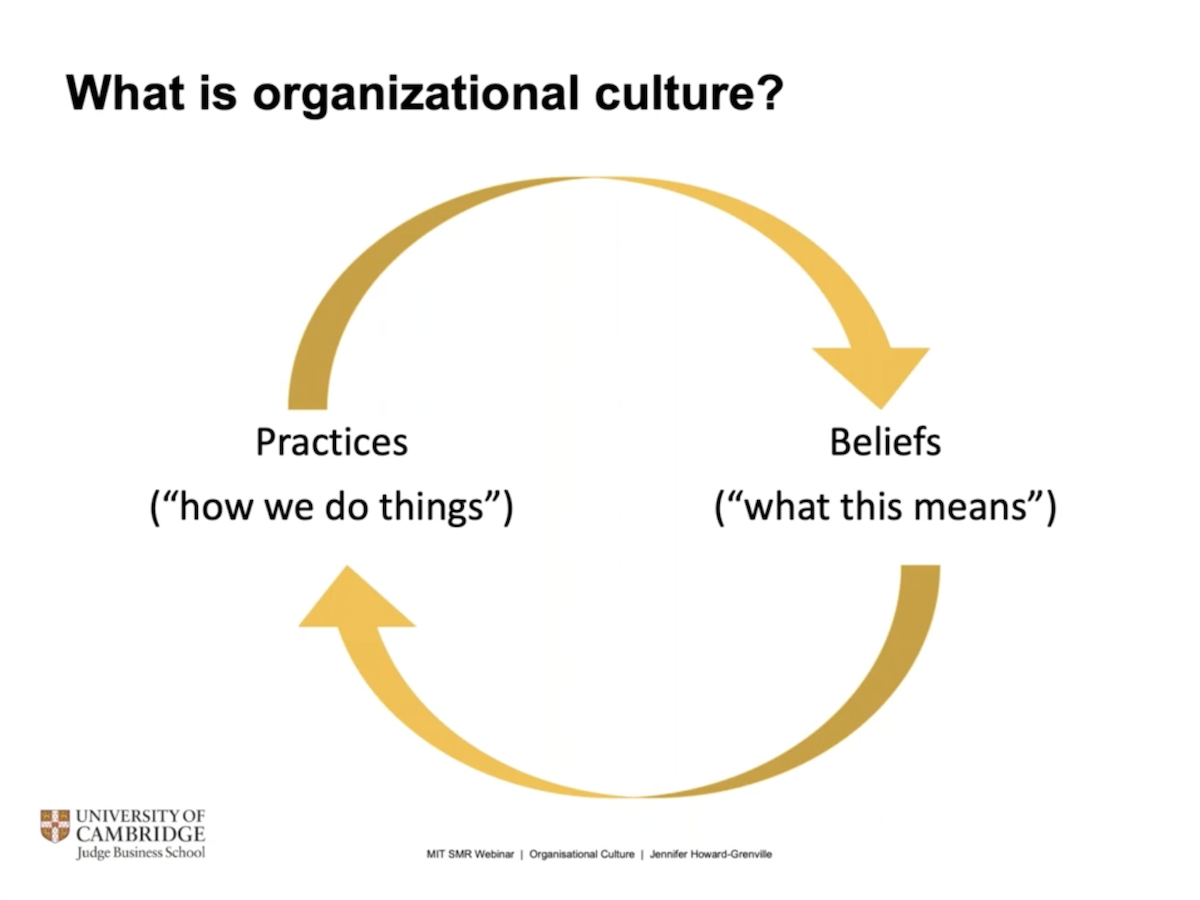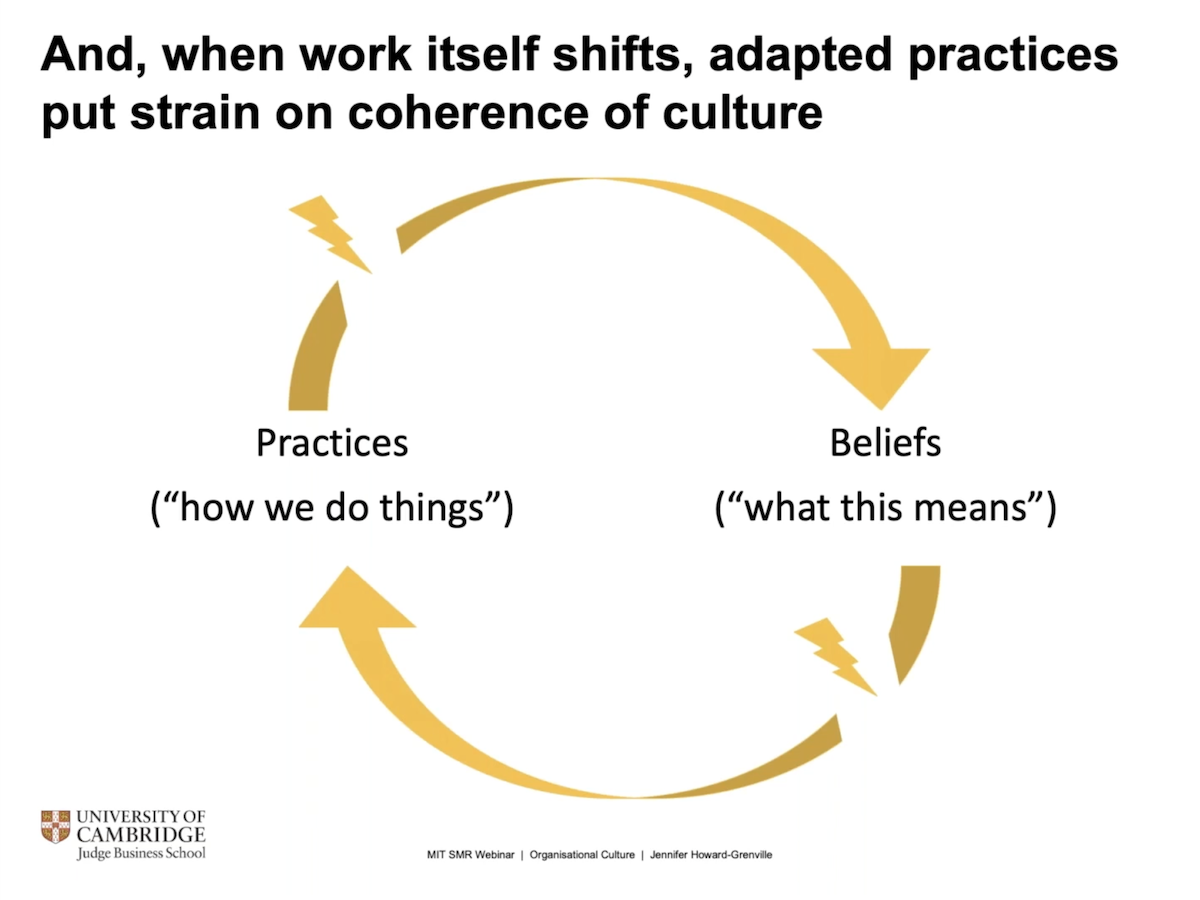5 Features of Workplace Culture

Key Takeaways
- Culture is shared, not dictated. Leaders can shape culture with policies and communication, but culture is always something larger and wilder.
- Organizational culture is often invisible because its tenets are taken for granted as basic assumptions. It's hard to recognize a culture until you step outside it.
Workplace culture, simply put, is the shared practices and beliefs that determine “how we do things here.”
Organizational culture researcher Jennifer Howard-Grenville describes these five aspects of workplace culture:
1. Culture is a system of practices and beliefs.
Howard-Grenville encourages observing your company’s culture as an anthropologist might. What daily behaviors do you see, and what choices? Imagine an anthropologist with no knowledge of your culture observed the actions of your team for a week. What would her conclusions be about why they were doing the things they do?
Howard-Grenville argues that practices should be tied to meaning in a reinforcing cycle. Disruptions and sudden changes break the cycle, causing a crisis of culture.


Slides from Howard-Grenville's webinar “Sustaining Culture When Everyone's Remote”
2. Culture is shared, not dictated.
Howard-Grenville says that even if a founder seeds culture, the group grows it. “Culture,” she says, “is how we as a group have grown to make sense of what we’re doing together.”
A company's culture differs from organizational goals or a mission statement written by upper management. These can influence or reflect culture. However, they don’t always represent the actual experiences and behaviors of employees at all levels.
3. Culture is a tool kit.
Howard-Grenville speaks of organizational culture as a tool kit, a view modeled after anthropologist Ann Swidler. The tool kit is made up of habits and practices. “Knowing how to use a culture’s tools—that is, when and how they apply—is the real mark of belonging to a culture.” Leaders must pay attention to what new habits are being formed, and which habits are being rewarded.
4. Culture is an open system.
Organizational culture exists within a larger culture or society, of course. An organization’s location, the demographics of its employees or customers, and more affect workplace culture. Events of the world, societal trends, family and community stressors, employees’ volunteer efforts—these are not separate from the culture inside your virtual walls. Rather, they filter in, informing the interactions and habits of your employees, and thus your culture.
5. Culture is often invisible.
Edgar R. Schein asserts that culture (“accumulated learning”) often comes to be “taken for granted as basic assumptions.” The culture “drop[s] out of awareness,” becomes invisible. Howard-Grenville agrees that we “often only recognize it when we step outside it.” Culture is the water your employees swim through.
Understanding and defining your company's culture
Cultures form whether or not a company speaks about them or tries to manage them. Defining your culture can be especially difficult if the organization is larger than a single team. Yet a common question posed by interested talent is “Can you tell me about your organization’s culture?” So it’s important to get as clear a picture of your culture or cultures as possible.
What stories do people tell about working at or with your organization? What do employees say during exit or stay interviews? What are they saying on public forums? Mine these sources for possible descriptions of your culture.
Interviews and unsolicited feedback can get at the emotionality of your culture better than numbers can.
Culture is built collaboratively
Everyone in the organization has a part in building culture, not just human resources or C-suite. It might begin with HR’s interviewing and onboarding processes, but it doesn’t end there.
Managers give it shape through their priorities and interactions. Every individual in the workplace responds in one way or another to the current culture. They can adapt to it or can strive to alter it.
Cultures can differ between departments or locations. Individual, societal, and professional mindsets, assumptions, and values will come into play alongside the organization’s overall culture.
Culture can even extend beyond the boundaries of an office building. It can include how an organization interacts with its customers and how it markets itself. Culture can also include what kind of corporate citizen it is. Do employees get time off to volunteer, and do leaders work with local educational institutions?
DiSC® and workplace culture
Group Culture Reports
Running an Everything DiSC® Group Culture Report for your team is a great way to gain an understanding of some of those invisible forces shaping your culture. This 13-page report gives you insight into why certain people may feel pressures others don’t, or find more or less success adapting to the overarching culture.
The Group Culture Report helps you determine and explore the advantages and disadvantages of your group’s DiSC culture, discuss its effect on group members, and examine its influence on decision-making and risk-taking. Learn more about Group Culture Reports and how DiSC styles work on the group level.
Catalyst
The Catalyst™ platform for Everything DiSC® is all about strengthening workplace culture through ongoing learning and conversation. Using DiSC to ground your discussions on culture gives people a common language, making it safe to offer concerns as reflections on styles rather than as complaints. Catalyst shows personalized tips for working with each person in your organization, such as how to give feedback or keep momentum going on a project. It is a way to surface the values and norms of your group, making it easier to see and discuss “the water you swim in”—your unseen culture.
Cultures develop with or without input and management. Defining the elements of culture which make a workplace healthy and productive is the first step toward cultivating more of them.
Posted 11/24/2020, Last Updated 12/12/2024







